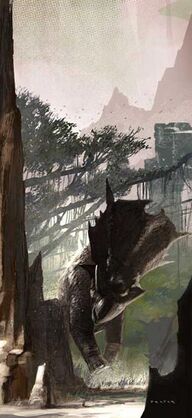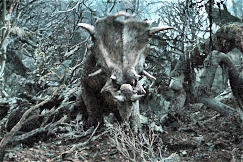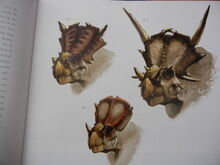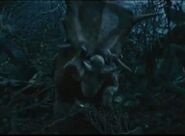|
Ferrucutus cerastes
| |
|
Name:
|
Ferrucutus cerastes
|
|
Abilities and Weapons:
|
Speed, Frill, Sharp Horns, Beak, Jaw Strength, Tackle, Strength, Keen Senses, Endurable, Feet, Stamina, Head Butt, Tail, Durability, Good Eyesight
|
|
Occupation:
|
Foraging primary consumer
|
|
Home:
|
Skull Island, now on Monster Isle
|
|
First Appearance:
|
"King Kong" (from 2005)
|
|
Diet:
|
Herbivore
|
|
Size
|
Length: 7.3-10.3 meters
Height: 4.5-6 meters Weight: 9-16 tons |
|
Status:
|
Rescued from extinction during the 1938 fall exploration of skull island.
|
Ferrucutus cerastes ("horned iron hide") is a extremely large 24-34 feet long (7.3-10.3 meters) species of Pachyrhinosaurus-like centrosaurine ceratopsid dinosaur that is found on Skull Island. The animal is described in the book "The World of Kong: A Natural History of Skull Island" (from 2005).
Among the most impressive and fairly numerous herbivores on Skull Island are the mighty Ferrucutus, a herd-dwelling dinosaur, found in groups or sole individuals. Herds can number up to around 12 individuals. Heavily built grazers/browsers with massive shoulders and enormous frills of bone and spike, these powerful animals are dangerous prey for the island’s carnivores.
Ecology[]
Despite their fearsome aspect and aggressive manner, Ferrucutus are exclusively herbivores, eating low shrubbery and using their nasal horns to uproot tall cycads to get to the fruit in the tender crown of the plants. Ferrucutus herds tend to follow the Brontosaurus herds, exploiting any jungle cleared by the huge animals. Jungle cleared by Brontosaurus herds is quickly reduced to grassland by these shrub-browsing ceratopsids, their hard beaks making short work of the thorns and woody stems. Skull Island dung beetles will follow herbivores like these and eat their scat.
Abilities/Tactics[]

Herds are strongly territorial, and will claim and defend a small area as their own, where eggs are laid and their young are raised, giving them time to develop in relative safety. Young immediately join the herd upon hatching and gain the protection of the group from such attackers as Lycaesaurus and Pugbats.
All herds are led by a male, who will fight off any challenger to his rule or any threat to his herd. When threatened by a predator, the females instinctively will gather in a circle around the young, presenting a wall of outward-facing horns and bony shields to an attacker while the dominant male will then rush forward to challenge the intruder. Males will charge, counting on their horns, shield, and massive neck and shoulder muscles to carry the day. Ferrucutus will also bite if needed, and their sharp beaks are capable of shearing through woody stems as well as flesh and bone. Their body is fully armored, making Ferructus have an endurable body to take attacks from predators and fight back. Their shown to have a heavy body but can move in high speeds to run from predators if they have too. However, their size and ferocity usually makes most predators back off. Even the biggest and hungriest V. rex will think twice about tackling an enraged bull Ferrucutus.

The head armament of a Ferrucutus is primarily used in dominance fights between adult males contesting lordship of their small herds of females and young. Intensely territorial and pugnacious, adult bulls can grow to almost half again as large as a cow. They collect small harems and guard them jealously.
Young males gather in "bachelor herds," practicing their sparring skills with playful bouts until they are large and strong enough to challenge a reigning male for their own dominance in a herd.
Fights between males are frequent, and can be violent and bloody, with injuries not uncommon and death not unheard of. Even superficially wounded bulls can die of nasty infections later.
Appearance[]

An appearance of a Ferrucutus.
Ferrucutus has the typical shape of a ceratopsian, with a heavy rhinolike body, a thick yet short tail, and a tall, oval-shaped bony shield extending up from the back of the head and over the shoulders. This shield has a series of spikes projecting from the edge, with two long horns coming off the nose. It is 24-34 feet long. The Ferrucutus seems to resemble between a Triceratops and a Pachyrhinosaurus, and other smaller ceratopsians from the Late Cretaceous.
Head Frills[]

“The larger the frill, the more senior the animal” seems to be the rule among the ceratopsians of Skull Island, especially with Ferrucutus. Starting out small in juveniles, the frills of the Ferrucutus grow throughout their lives, with the older individuals sporting huge and elaborate horned frills. Adult females have large frills and horns, but by far the most impressive arrays are those of the big adult males. Some bulls have horns over six feet long. In mature individuals, the face of the frill above the brows will change color in the breeding season to indicate readiness to mate. In some cases this display is enough to intimidate a competitor into giving up before any violence occurs. Among females, the secondary cheek horns are barely noticeable and the small horns at the center top of the frill rarely grow long enough to cross. Only the largest males develop a full crossover, and this is good measure of the age of the individual.
Skeletal Adaptations[]
With powerful shoulder muscles and huge, heavy skulls, the skeletons of Ferrucutus are heavily reinforced. Huge forelimbs give them traction in head sparring and in uprooting stubborn plants. The neck is built to transmit impact from the skull and spreads it throughout the body, diffusing jolts as males fight. All the limbs are drawn directly under the body to support the animals’ sturdy physique.
Relationship with Skull Island Termites[]
Vertebrates like Ferrucutus actively provoke the Skull Island Termites to swarm over their hides by rubbing themselves against mounds. While their own skins are tough enough to withstand the termites’ bites, unwelcome dermal parasites on the hides are not so lucky.
History[]
A Ferrucutus was briefly seen drinking from a lake near Kong's lair. In the extended cut of the film, an enraged Ferrucutus attacked the search party for Ann Darrow. It knocked several party members around with its crest and tail before it cornered Jack Driscoll. The Ferrucutus was eventually brought down and killed by Hayes.
Trivia[]
- The Ferrucutus was the replacement for the Stegosaurus from the 1933 film.
- The way the Ferrucutus moved it's tail while dying is similar to the Stegosaurus twitching its tail in the original 1933 film.
- Along with the Foetodon, they don't appear in the Video Game adaption.
- It's similar to Pachyrhinosaurus, a ceratopsid that lived in Canada in 73-70 million years ago.
- the Ferrucutus in the extended versione of the movie (Is male)
- The Ferrucutus (male) in the movie Is named sparkie.
- A Ferrucutus have a small tail and a big horns.
- Like all animals from Skull Island. It is unknown what they faced during the sinking of the island. Given the multiple expeditions, there may be a chance that a few surviving populations was saved off-land to a more stable enclosure.
Appearances[]
- King Kong (2005 film) (extended edition scene and original edition sence) and by the waterfall to Kong's lair.

















